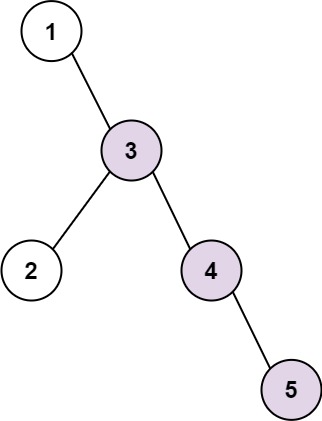Table of Contents
Problem Statement
Binary Tree Longest Consecutive Sequence LeetCode Solution – Given the root of a binary tree, return the length of the longest consecutive sequence path.
The path refers to any sequence of nodes from some starting node to any node in the tree along with the parent-child connections. The longest consecutive path needs to be from parent to child (cannot be the reverse).

Input: root = [1,null,3,2,4,null,null,null,5] Output: 3 Explanation:
sequence path is 3-4-5, so return 3.
Explanation For Binary Tree Longest Consecutive Sequence
Just very intuitive depth-first search, send cur node value to the next level and compare it with the next level node.
Code for Binary Tree Longest Consecutive Sequence LeetCode Solution
C++ Code
class Solution {
public:
int longestConsecutive(TreeNode* root) {
return search(root, nullptr, 0);
}
int search(TreeNode *root, TreeNode *parent, int len) {
if (!root) return len;
len = (parent && root->val == parent->val + 1)?len+1:1;
return max(len, max(search(root->left, root, len), search(root->right, root, len)));
}
};Java Code
public class Solution {
private int max = 0;
public int longestConsecutive(TreeNode root) {
if(root == null) return 0;
helper(root, 0, root.val);
return max;
}
public void helper(TreeNode root, int cur, int target){
if(root == null) return;
if(root.val == target) cur++;
else cur = 1;
max = Math.max(cur, max);
helper(root.left, cur, root.val + 1);
helper(root.right, cur, root.val + 1);
}
}Python Code
class Solution:
def longestConsecutive(self, root: TreeNode) -> int:
def longest_path(root):
if not root:
return 0
length = 1
l = longest_path(root.left)
r = longest_path(root.right)
if root.left and root.left.val == root.val + 1:
length = max(length, 1 + l)
if root.right and root.right.val == root.val + 1:
length = max(length, 1 + r)
res[0] = max(res[0], length)
return length
res = [0]
longest_path(root)
return res[0]Complexity Analysis For Binary Tree Longest Consecutive Sequence
Time Complexity: O(n) DFS traversal of a binary tree with n nodes takes O(n) time.
Space Complexity: O(1) no extra space is used.